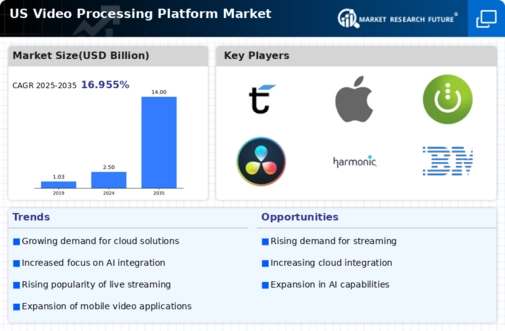The US Video Processing Platform Market is characterized by rapid technological advancements and an increasing demand for high-quality video content. This market serves a diverse range of industries including entertainment, media, sports, and education, driving competition among key players to innovate and refine their service offerings. As streaming services continue to gain prominence, there is a pivotal focus on platforms that can enhance video processing capabilities, offering features like real-time transcoding, adaptive bitrate streaming, and advanced analytics.
The competitive landscape is marked by both established companies and emerging startups, each vying to capture market share through differentiation in technology, pricing, and customer service. This dynamic environment necessitates continuous evolution to meet changing consumer expectations and harness new market opportunities.
Telestream has established a strong foothold in the US Video Processing Platform Market, distinguished by its commitment to high-quality broadcasting and video streaming solutions. The company offers an extensive suite of products that address the unique needs of broadcasters and content creators, particularly in live production environments. Its strengths lie in its advanced encoding and transcoding capabilities, which are essential for delivering video across multiple platforms while maintaining optimal quality. Furthermore, Telestream's robust support services and ongoing innovation in the realm of cloud-based video processing have enhanced its reputation as a reliable partner in the industry.
Through its strategic collaborations and partnerships, Telestream consistently expands its market presence, ensuring it remains competitive in a landscape increasingly dominated by integrated media solutions.
Apple is another formidable player in the US Video Processing Platform Market, leveraging its technological prowess and brand loyalty to capture a significant share. The company's key products include Final Cut Pro and Compressor, which are widely regarded for their powerful video editing and processing capabilities tailored to professionals within the film and music industries. Apple’s strengths emerge from its seamless integration of hardware and software, facilitating a user experience that is both efficient and intuitive. The company has made strategic moves, including recent acquisitions aimed at bolstering its video processing technologies, further solidifying its position in the market.
Additionally, Apple's ongoing investments in streaming services, combined with its focus on enhancing its ecosystem, contribute to its competitive edge and ability to deliver top-notch video processing solutions to a diverse range of users across the United States.






















Leave a Comment